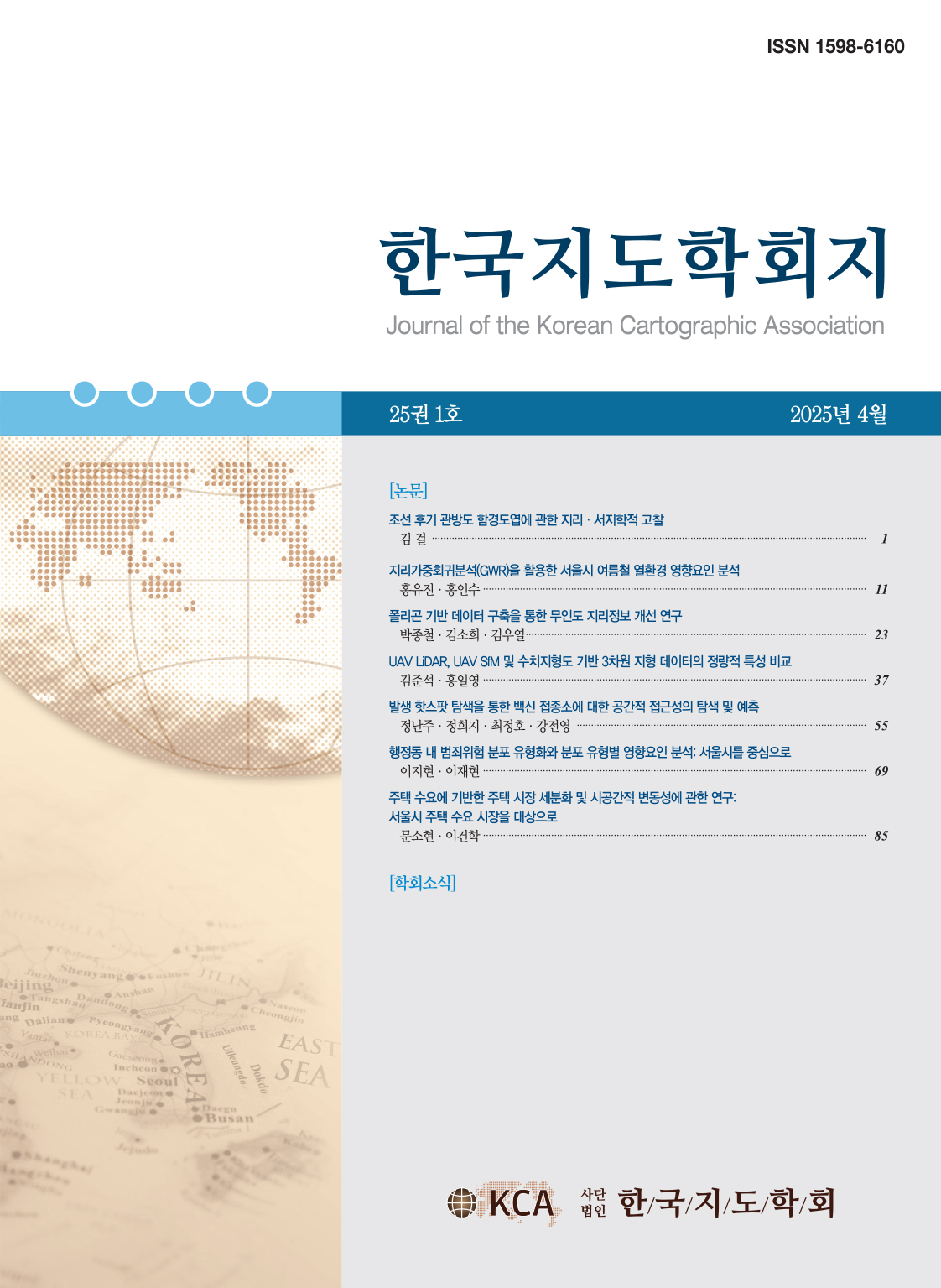Research Article
Abstract
References
Information
An urban park is a leisure space for citizens and the extent to which the park is visited can thus be a useful index for measuring the degree of social utility provided by the park. This study proposes the Visit Potential Index (VPI) which evaluates the extent to which an urban park is visited based on its locational properties. The VPI combines the concepts of spatial accessibility and opportunity fungibility by considering spatial efficiency as well as equity. The spatial accessibility of an urban park is calculated by the number of residents within the service area of the park, while the opportunity fungibility of an urban park is defined in terms of the availability of neighboring parks. Since spatial accessibility and opportunity fungibility are demand- and supply-side concepts respectively, the VPI can effectively reveal the locations that should be provided with more park service. As a case study, we evaluate the visit potential of urban natural park districts in Seoul, which are of increasing social interest, in regard to the Sunset law. The VPI is expected to be utilized for evaluating new and existing locations of urban parks by providing a more flexible way of assessing their locational values from multiple angles.
도시공원은 시민의 여가 공간으로 시민들이 공원을 방문하는 정도는 공원이 제공하는 사회적 효용을 측정하는 유용한 지표로 활용될 수 있다. 본 연구는 도시공원의 입지적 특성을 바탕으로 시민들이 도시공원을 방문하는 정도를 평가하는 방문 잠재력 지수를 제안한다. 방문 잠재력 지수는 도시공원 입지의 공간적 효율성과 형평성을 동시에 고려하여 공간 접근성과 기회 대체성을 결합하고 있다. 도시공원의 공간 접근성은 공원의 서비스 권역 내에 거주하는 인구 분포로 측정했으며, 도시공원의 기회 대체성은 인접 공원의 이용 가능성으로 측정하였다. 도시공원의 공간 접근성과 기회 대체성은 각각 수요와 공급 정도를 나타내는 개념으로 이를 결합한 방문 잠재력 지수는 공원의 공급 필요성이 큰 입지를 효과적으로 보여줄 수 있다. 사례 분석으로 도시공원 일몰제로 사회적 관심의 대상이 되고 있는 서울시 도시자연공원구역의 방문 잠재력을 실증적으로 평가하였다. 본 연구에서 제안하는 도시공원 방문 잠재력 지수는 도시공원의 입지적 가치를 다각도에서 포착하고 유연한 평가 방식을 제공함으로써 기존 입지와 신규 후보 입지 모두를 평가하는데 유용하게 쓰일 수 있을 것으로 기대된다.
- 김영・김경환・조재영, 2001, "다기준 의사결정모형과 GIS 를 이용한 공원입지선정: 전주시의 GB 해제지역을 대상으로," 국토계획, 36(6), 57-67.
- 김원주・진정규, 2015, 「장기미집행 시설녹지 보상 우선순위 기준 정립방안」, 서울연구원 정책과제연구보고서, 1-99.
- 문소현・이건학, 2020, "지역 제한 P-median 모델을 이용한 서울시 주거복지센터 입지 분석 및 모델링," 대한지리학회지, 55(2), 197-206.
- 이건학・신정엽・신성희, 2010, "GIS 기반의 다기준 의사결정분석 기법을 이용한 시립 미술관 입지 적합성 분석 연구: 인천시를 사례로," 한국도시지리학회지, 13(3), 89-105.
- 이건학, 2010, "동통폐합에 따른 동주민센터의 입지 변화 분석과 최적 입지 모델링: 공간적 효율성 및 형평성 접근," 대한지리학회지, 45(4), 521-539.
- 이경주・임은선, 2009, "근린공원 입지계획지원을 위한 공급적정성 평가방법에 관한 연구," 국토연구, 107-122. 10.15793/kspr.2009.63..006
- 이경주・안명준・이상민, 2015, "서비스 편익을 고려한 미집행 도시공원 집행 우선순위 의사결정 지원 입지모형," 한국지도학회지, 15(2), 51-65. 10.16879/jkca.2015.15.2.051
- 이진우・윤갑식, 2018, "접근성을 고려한 도시공원의 공급 우선순위 분석: 부산광역시 남구를 대상으로," 지방정부연구, 22(2), 77-90. 10.20484/klog.22.2.4
- 진찬우・이건학, 2015, "행복주택 최적 입지 선정에 관한 연구: 다목적 공간 최적화 접근," 한국도시지리학회지, 18(2), 81-95.
- 조준형・손소영, 2017, "공급적정성및 서비스 효용성 평가를 기반한 도보권 근린공원의 최적입지 선정,"
Journal of Korea Planning Association , 52(2), 203-219. - Halpern, J., 1976, The location of a center-median convex combination on an undirected tree,
Journal of Regional Science , 16(2), 237-245. 10.1111/j.1467-9787.1976.tb00966.x - Heynen, N., Perkins, H.A., and Roy, P., 2006, The political ecology of uneven urban green space: The impact of political economy on race and ethnicity in producing environmental inequality in Milwaukee,
Urban Affairs Review , 42(1), 3-25. 10.1177/1078087406290729 - McAllister, D.M., 1976, Equity and efficiency in public facility location,
Geographical Analysis , 8(1), 47-63. 10.1111/j.1538-4632.1976.tb00528.x - Oh, K. and Jeong, S., 2007, Assessing the spatial distribution of urban parks using GIS,
Landscape and Urban Planning , 82(1-2), pp.25-32. 10.1016/j.landurbplan.2007.01.014 - Park, K., Rigolon, A., Choi, D.A., Lyons, T., and Brewer, S., 2021, Transit to parks: An environmental justice study of transit access to large parks in the US West,
Urban Forestry & Urban Greening , 60, 127055. 10.1016/j.ufug.2021.127055 - Razak, M.A.W.A., Othman, N., and Nazir, N.N.M., 2016, Connecting people with nature: Urban park and human well-being,
Procedia-Social and Behavioral Sciences , 222, 476-484. 10.1016/j.sbspro.2016.05.138 - Wolch, J.R., Byrne, J., and Newell, J.P., 2014, Urban green space, public health, and environmental justice: The challenge of making cities 'just green enough',
Landscape and Urban Planning , 125, 234-244. 10.1016/j.landurbplan.2014.01.017 - Xiao, Y., Wang, Z., Li, Z., and Tang, Z., 2017, An assessment of urban park access in Shanghai-Implications for the social equity in urban China,
Landscape and Urban Planning , 157, 383-393. 10.1016/j.landurbplan.2016.08.007 - Yu, S., Zhu, X., and He, Q., 2020, An assessment of urban park access using house-level data in urban China: Through the lens of social equity,
International Journal of Environmental Research and Public Health , 17(7), 2349. 10.3390/ijerph17072349 32244280 PMC7177907 - 조선비즈, 2020년 9월 10일, "도시공원 일몰제 후폭풍… 소유주 줄소송 현실화," https://biz.chosun.com/site/ data/html_dir/2020/09/10/2020091001579.html
- 공공데이터포털, https://www.data.go.kr
- 국가공간정보포털 오픈마켓, http://data.nsdi.go.kr/dataset
- 서울 열린데이터 광장, https://data.seoul.go.kr
- 서울의 산과 공원, http://parks.seoul.go.kr
- Publisher :The Korean Cartographic Association
- Publisher(Ko) :한국지도학회
- Journal Title :Journal of the Korean Cartographic Association
- Journal Title(Ko) :한국지도학회지
- Volume : 21
- No :1
- Pages :75-88
- DOI :https://doi.org/10.16879/jkca.2021.21.1.075



 Journal of the Korean Cartographic Association
Journal of the Korean Cartographic Association





